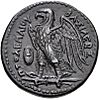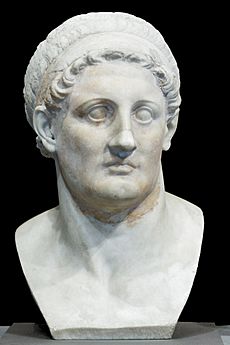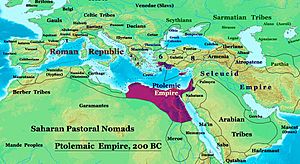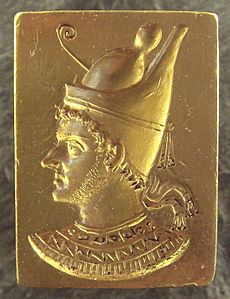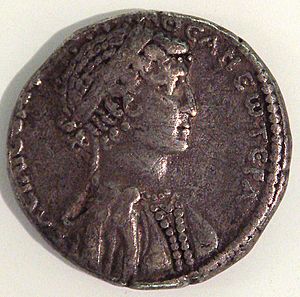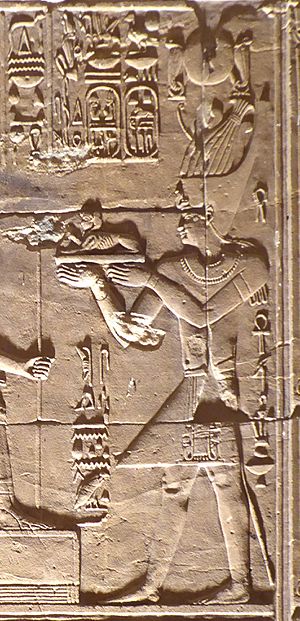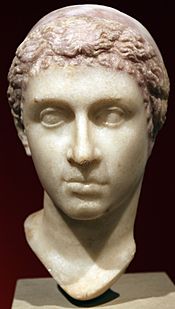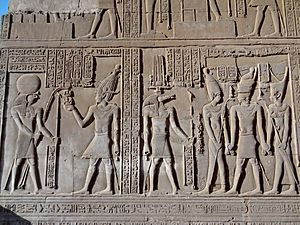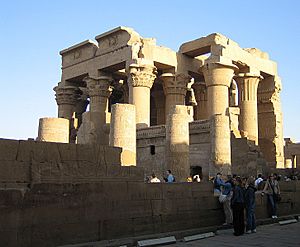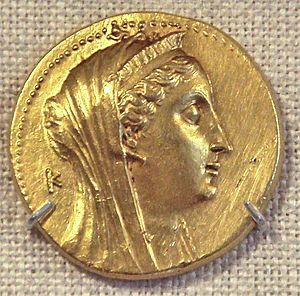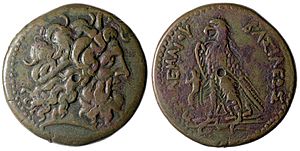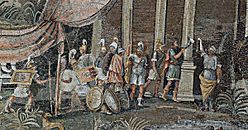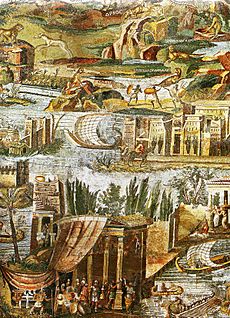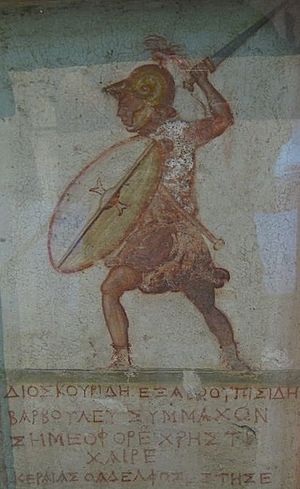Ptolemaic Kingdom facts for kids
Quick facts for kids
Ptolemaic Kingdom
Πτολεμαϊκὴ βασιλεία
Ptolemaïkḕ basileía |
|||||||||||
|---|---|---|---|---|---|---|---|---|---|---|---|
| 305 BC – 30 BC | |||||||||||
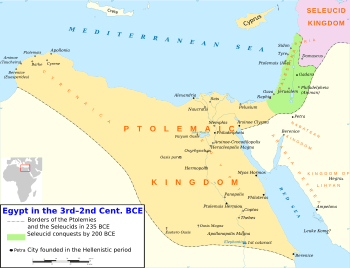
Ptolemaic Egypt circa 235 BC. The green areas were lost to the Seleucid Empire thirty five years later.
|
|||||||||||
| Capital | Alexandria | ||||||||||
| Common languages | |||||||||||
| Religion |
|
||||||||||
| Government | Hellenistic monarchy | ||||||||||
| Pharaoh | |||||||||||
|
• 305–283 BC
|
Ptolemy I Soter (first) | ||||||||||
|
• 51–30 BC
|
Cleopatra VII (last) | ||||||||||
| Historical era | Classical antiquity | ||||||||||
|
• Established
|
305 BC | ||||||||||
|
• Disestablished
|
30 BC | ||||||||||
| Population | |||||||||||
|
• 150 BCE
|
4.9–7.5 million | ||||||||||
| Currency | Greek Drachma | ||||||||||
|
|||||||||||
The Ptolemaic Kingdom (Koinē Greek: Πτολεμαϊκὴ βασιλεία, romanized: Ptolemaïkḕ basileía) was an Ancient Greek kingdom. It was based in Egypt during the Hellenistic Period. This kingdom started in 305 BC. It was founded by Ptolemy I Soter, a close friend of Alexander the Great. The kingdom lasted until the death of Cleopatra VII in 30 BC. The Ptolemies ruled for almost 300 years. They were the longest and last ancient Egyptian dynasty.
Alexander the Great took control of Egypt in 332 BC. At that time, Egypt was ruled by the Persians. After Alexander's death in 323 BC, his huge empire broke apart. His generals, called the diadochi, fought over who would rule. Ptolemy was a Macedonian general. He was one of Alexander's most trusted friends. Ptolemy won control of Egypt from his rivals. He then declared himself pharaoh.
Alexandria was a Greek city founded by Alexander. It became the capital of the kingdom. For centuries, Alexandria was a major center for Greek culture, learning, and trade. The Ptolemaic Kingdom grew to include eastern Libya, the Sinai, and northern Nubia. This happened after wars with the Seleucid Empire, another Hellenistic kingdom.
To be seen as rightful rulers by native Egyptians, the Ptolemies took on the title of pharaoh. They were shown on monuments in Egyptian style and clothing. However, the kings kept their Greek ways and traditions. The kingdom had a complex government system. This system used Egypt's rich resources. The Greek ruling class benefited most from this. They controlled the military, politics, and economy. They rarely mixed with Egyptian society. Native Egyptians kept power over local and religious groups. They slowly gained more power in the government if they adopted Greek culture.
Starting with Ptolemy II Philadelphus, the Ptolemies began to use Egyptian customs. For example, they started marrying their siblings. This was like the Osiris myth. They also took part in Egyptian religious life. New temples were built, and old ones were fixed. The kings gave a lot of support to the priests.
From the mid-3rd century BC, Ptolemaic Egypt was the richest and most powerful of Alexander's successor states. It was a leading example of Greek civilization. But in the mid-2nd century BC, family fights and wars made the kingdom weaker. It started to rely more on the Roman Republic. Under Cleopatra VII, Egypt got caught in a Roman civil war. This led to Rome taking over Egypt. It was the last independent Hellenistic state. Roman Egypt became one of Rome's richest provinces. It was also a center of Macedonian culture. Greek remained the main language of government until the Muslim conquest in 641 AD. Alexandria stayed a major city in the Mediterranean until the late Middle Ages.
Contents
History of the Ptolemaic Kingdom
The time when the Ptolemies ruled Egypt is well-known. This is because many papyri and ostraca have been found. These writings are in Koine Greek and Egyptian.
How the Ptolemaic Kingdom Started
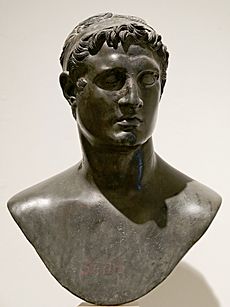
In 332 BC, Alexander the Great, King of Macedon, invaded Egypt. At that time, Egypt was part of the Persian Empire. Alexander visited Memphis. He also went to the oracle of Amun at the Siwa Oasis. The oracle said he was the son of Amun.
Alexander showed respect for Egyptian religion. This made the Egyptians happy. But he put Macedonians in almost all the important jobs. He also started a new Greek city, Alexandria. This city became the new capital. Egypt's wealth could now help Alexander conquer the rest of the Persian Empire. In early 331 BC, he left Egypt for Phoenicia. He left Cleomenes of Naucratis in charge of Egypt. Alexander never came back to Egypt.
After Alexander died in Babylon in 323 BC, his generals fought for control. At first, Perdiccas ruled the empire as a temporary leader. He appointed Ptolemy, one of Alexander's closest friends, to be the governor of Egypt. Ptolemy ruled Egypt from 323 BC. He was supposed to rule in the name of Alexander's half-brother and infant son.
However, Alexander's empire fell apart. Ptolemy soon became the ruler of Egypt on his own. He successfully defended Egypt from an invasion in 321 BC. He made his power strong in Egypt and nearby areas. This happened during the Wars of the Diadochi. In 305 BC, Ptolemy took the title of King. He became Ptolemy I Soter ("Saviour"). He started the Ptolemaic dynasty. This family ruled Egypt for almost 300 years.
All the male rulers in this family were named Ptolemy. Princesses and queens often used names like Cleopatra, Arsinoë, and Berenice. The Ptolemaic kings married their sisters. This was an Egyptian custom. Many kings ruled with their wives, who were also from the royal family. This custom made later Ptolemies weaker. Only Berenice III and Berenice IV officially ruled alone. Cleopatra V ruled with another woman, Berenice IV. Cleopatra VII officially ruled with her brothers. But she was the real ruler of Egypt.
The early Ptolemies did not change the Egyptians' religion or customs. They built beautiful new temples for the Egyptian gods. They also started to act like the pharaohs of old. Rulers like Ptolemy I Soter respected the Egyptian people. They knew how important their religion and traditions were. During the reigns of Ptolemy II and III, thousands of Macedonian soldiers were given farmland. Macedonians settled in towns and villages across the country. Upper Egypt, which was far from the capital, was less affected. But within 100 years, Greek influence had spread. Marriages between Greeks and Egyptians created a large educated class. Still, Greeks remained a special group in Ptolemaic Egypt. They lived under Greek law and had Greek education. They were citizens of Greek cities.
Rise of Ptolemaic Power
Ptolemy I: The Founder
The first part of Ptolemy I's rule was spent fighting. These were the Wars of the Diadochi. His main goal was to keep Egypt safe. He also wanted to make his kingdom bigger. In a few years, he controlled Libya, Coele-Syria (including Judea), and Cyprus. When Antigonus, the ruler of Syria, tried to reunite Alexander's empire, Ptolemy joined forces against him. In 312 BC, Ptolemy and Seleucus defeated Antigonus's son, Demetrius, at the battle of Gaza.
A peace agreement was made in 311 BC. But war started again in 309 BC. Ptolemy took over Corinth and other parts of Greece. However, he lost Cyprus after a naval battle in 306 BC. Antigonus then tried to invade Egypt, but Ptolemy stopped him. In 302 BC, Ptolemy joined a new group against Antigonus. But he was not there when Antigonus was defeated and killed. Instead, Ptolemy took control of Coele-Syria and Palestine. This broke an agreement with Seleucus and led to future wars. After this, Ptolemy tried to avoid land wars. But he took Cyprus back in 295 BC.
Ptolemy felt his kingdom was safe. So, he shared power with his son, Ptolemy II, in 285 BC. He might have spent his retirement writing a history of Alexander's wars. This book is now lost. Ptolemy I died in 283 BC at 84 years old. He left a strong and well-run kingdom to his son.
Ptolemy II: The Cultured King
Ptolemy II Philadelphus became pharaoh of Egypt in 283 BC. He was a peaceful and cultured ruler. Unlike his father, he was not a great warrior. Luckily, Ptolemy I had left Egypt strong and rich. Three years of fighting in the First Syrian War made the Ptolemies masters of the eastern Mediterranean. They controlled the Aegean islands and coastal areas. However, some of these lands were lost later in his rule. This happened during the Second Syrian War. In the 270s BC, Ptolemy II defeated the Kingdom of Kush. This gave the Ptolemies access to Kushite land. They also gained control of important gold mines south of Egypt. The Ptolemies set up hunting spots and ports far south. From there, groups searched for war elephants. Greek culture became very important in Kush at this time.
Ptolemy II loved learning. He paid for the Library of Alexandria to grow. He also supported scientific research. Poets like Callimachus and Theocritus received money. They wrote great Greek poems. Other scholars included the mathematician Euclid. The astronomer Aristarchus also worked under Ptolemy. Ptolemy is thought to have asked Manetho to write his Aegyptiaca. This was a history of Egypt. It might have helped the new rulers understand Egyptian culture.
Ptolemy's first wife, Arsinoe I, had his children. After he divorced her, he married his sister, Arsinoe II. This was an Egyptian custom. This practice, while liked by Egyptians, caused problems later. The Alexandrian court was very grand under Ptolemy II. Poets praised the Ptolemaic family. Ptolemy spent a lot to make Alexandria a center for trade, art, and knowledge. The libraries of Alexandria helped save many Greek writings.
Ptolemy III: The Benefactor
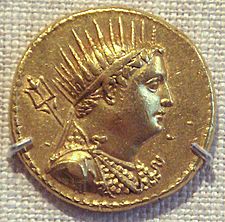
Ptolemy III Euergetes ("the Benefactor") became king in 246 BC. He changed his father's policy. He got involved in wars with other Macedonian kingdoms. He joined the Third Syrian War. This was against the Seleucid Empire in Syria. His sister, Queen Berenice, and her son were killed. Ptolemy marched into the heart of the Seleucid lands. His fleets in the Aegean Sea conquered new areas.
This victory showed the Ptolemaic power at its peak. Seleucus II Callinicus kept his throne. But Egyptian fleets controlled most of the coasts of Anatolia and Greece. After this win, Ptolemy did not fight actively in wars. But he supported enemies of Macedon in Greek politics. His rule was different because he supported native Egyptian religion more. He left more signs on Egyptian monuments. His reign shows the Ptolemies slowly becoming more Egyptian.
Ptolemy III continued to support learning and literature. The Great Library got a second library. It was built in the Serapeum. He was said to have taken every book from ships in Alexandria. He copied them, then returned the copies. He kept the originals for the Library. He even borrowed important writings from Aeschylus, Sophocles, and Euripides from Athens. He paid a large deposit but kept the originals. The most famous scholar at Ptolemy III's court was Eratosthenes. He was known for calculating the circumference of the world very accurately.
Ptolemy III paid for building projects at temples across Egypt. The most important was the Temple of Horus at Edfu. This is a masterpiece of ancient Egyptian temple design. It is now the best-preserved Egyptian temple. Ptolemy III started building it on August 23, 237 BC. Work continued for most of the Ptolemaic dynasty. The main temple was finished in 212 BC. The whole complex was completed in 142 BC.
Decline of the Ptolemaic Kingdom
Ptolemy IV: A Weak King
In 221 BC, Ptolemy III died. His son, Ptolemy IV Philopator, became king. He was a weak ruler. His reign started with the murder of his mother. He was always controlled by his favorite advisors. However, his ministers prepared well for attacks from Antiochus III the Great. The great Egyptian victory at Raphia in 217 BC made the kingdom safe. But there were rebellions by native Egyptians. These rebellions took away half the country for over 20 years. Philopator was interested in wild religious parties and literature. He married his sister Arsinoë. But his mistress, Agathoclea, controlled him.
Like earlier kings, Ptolemy IV acted like a typical Egyptian Pharaoh. He strongly supported Egyptian priests. He gave them money and built temples. Ptolemy III had started a meeting of all Egyptian priests in 238 BC. Ptolemy IV continued this. He held his own meeting in Memphis in 217 BC. This was after the victory celebrations of the Fourth Syrian War. This meeting resulted in the Raphia Decree. It was issued on November 15, 217 BC. This decree was written in hieroglyphs, Demotic, and Koine Greek. The decree tells about the military success of Ptolemy IV and Arsinoe III. It also mentions their gifts to the Egyptian priests. Ptolemy IV is shown as Horus. He avenges his father by defeating the forces of disorder. In return, the priests agreed to put up statues in their temples. These statues showed the temple god giving a victory sword to Ptolemy IV and Arsinoe III. A five-day festival was started to honor the royal couple and their victory. This decree shows a mix of Egyptian pharaoh ideas and Greek ideas of a victorious king.
Rebellions in the South
Bad rule by the Pharaoh in Alexandria led to a big revolt. A priest named Hugronaphor led it. He called himself Pharaoh in 205 BC. He ruled Upper Egypt until he died in 199 BC. His son Ankhmakis took over. His forces almost pushed the Ptolemies out of Egypt. The rebel family was finally defeated in 185 BC. A stone celebrating this event is the famous Rosetta Stone.
Ptolemy V and Ptolemy VI

Ptolemy V Epiphanes, son of Philopator and Arsinoë, was a child when he became king. Several regents ruled the kingdom for him. Antiochus III the Great of the Seleucid Empire and Philip V of Macedon agreed to take over Ptolemaic lands. Philip took islands and places in Caria and Thrace. The battle of Panium in 200 BC gave Coele-Syria from Ptolemaic to Seleucid control. After this defeat, Egypt made an alliance with Rome. Once he grew up, Epiphanes became a harsh ruler. He died young in 180 BC. His infant son, Ptolemy VI Philometor, took his place.
In 170 BC, Antiochus IV Epiphanes invaded Egypt. He captured Philometor. He made him a puppet king in Memphis. Philometor's younger brother (later Ptolemy VIII Physcon) was made king by the Ptolemaic court in Alexandria. When Antiochus left, the brothers agreed to rule together. Their sister Cleopatra II also joined them. But they soon argued. Their fights allowed Rome to get involved. Rome slowly increased its power in Egypt. Philometor eventually got his throne back. In 145 BC, he was killed in the Battle of Antioch.
During the 160s and 150s BC, Ptolemy VI took back control of northern Nubia. This achievement is shown at the Temple of Isis at Philae. This temple received tax money from the Dodecaschoenus region in 157 BC. Pictures on the temple show the Ptolemaic claim to rule all of Nubia. An inscription shows that some Nubian leaders paid tribute to the Ptolemaic treasury. To secure the area, the general of Upper Egypt, Boethus, founded two new cities. They were named Philometris and Cleopatra, after the king and queen.
Later Ptolemaic Rulers
After Ptolemy VI died, civil wars and family feuds began. These lasted for over a century. Philometor's infant son, Ptolemy VII Neos Philopator, became king. But Physcon soon returned. He killed his young nephew and took the throne. As Ptolemy VIII, he was a cruel ruler. When he died in 116 BC, he left the kingdom to his wife Cleopatra III and her son Ptolemy IX Philometor Soter II. The young king was driven out by his mother in 107 BC. She ruled with her youngest son, Ptolemy X Alexander I. In 88 BC, Ptolemy IX returned to the throne. He kept it until he died in 80 BC. His successor was Ptolemy XI Alexander II, son of Ptolemy X. The people of Alexandria killed him. This happened after he murdered his stepmother, who was also his cousin, aunt, and wife. These family fights made Egypt so weak. It became like a Roman protectorate. Rome had already taken over most of the Greek world.
Ptolemy XI was followed by Ptolemy XII Neos Dionysos. He was nicknamed Auletes, "the flute-player." By now, Rome decided what happened in Egypt. Rome took over Libya and Cyprus. In 58 BC, the people of Alexandria drove Auletes out. But the Romans put him back in power three years later. He died in 51 BC. He left the kingdom to his 10-year-old son and 17-year-old daughter. These were Ptolemy XIII Theos Philopator and Cleopatra VII. They ruled together as husband and wife.
Final Years of the Ptolemaic Kingdom
Cleopatra VII: The Last Pharaoh
Cleopatra VII became queen of Egypt on March 22, 51 BC. This was after her father, Ptolemy XII, died. She ruled as queen and pharaoh with different male co-rulers from 51 to 30 BC.
The Ptolemies' power ended as the Roman Republic grew stronger. Empires were falling to Macedon and the Seleucid empire. The Ptolemies had to become allies with the Romans. This alliance lasted over 150 years. By Ptolemy XII's time, Rome had a lot of power over Egypt's politics and money. He even declared the Roman senate the protector of the Ptolemaic Dynasty. He paid huge amounts of Egyptian wealth to the Romans. This was to get his throne back after a rebellion by his older daughters. Both daughters were killed when Auletes got his throne back. This left Cleopatra VII as the oldest surviving child. Ptolemaic royal siblings traditionally married each other. These marriages sometimes had children. Other times, they were just for political power. Ptolemy Auletes wanted Cleopatra and her brother Ptolemy XIII to marry and rule together. He wrote this in his will. The Roman senate was named as the executor. This gave Rome even more control over Egypt.
After their father died, Cleopatra VII and her younger brother Ptolemy XIII became rulers. They were married, but it was only in name. Their relationship quickly got worse. Ptolemy XIII's advisors took away Cleopatra's power. She fled and tried to raise an army to get her throne back.
Julius Caesar went to Alexandria in 48 BC. He wanted to stop the civil war there. War in Egypt would hurt trade with Rome. Egypt supplied Rome with grain and other goods. While in Alexandria, Caesar met 22-year-old Cleopatra. She was reportedly brought to him secretly in a carpet. Caesar agreed to support Cleopatra's claim to the throne. Ptolemy XIII and his advisors fled. They turned Egyptian forces against Caesar and Cleopatra. They hid in the palace until Roman help arrived. Ptolemy XIII's forces were defeated at the Battle of the Nile. The king was killed, reportedly drowning in the Nile.
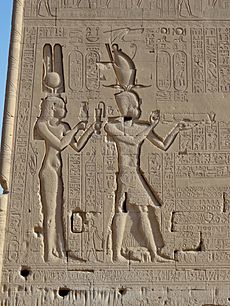
In the summer of 47 BC, Cleopatra married her younger brother Ptolemy XIV Philopator. She then went on a two-month trip along the Nile with Caesar. They visited Dendara, where Cleopatra was worshipped as pharaoh. This was an honor Caesar could not have. They became lovers, and she had his son, Caesarion. In 45 BC, Cleopatra and Caesarion went to Rome. They stayed in a palace built by Caesar for them.
In 44 BC, Caesar was killed in Rome by some Senators. After his death, Rome was split. Some supported Mark Antony, others Octavian. When Mark Antony seemed to be winning, Cleopatra supported him. Soon after, they became lovers and married in Egypt. (Roman law did not recognize their marriage, as Antony was married to a Roman woman). They had three children: twins Cleopatra Selene and Alexander Helios, and another son, Ptolemy Philadelphos.
Mark Antony's alliance with Cleopatra made Rome even angrier. Romans called her a power-hungry sorceress. They accused her of tricking Antony to conquer Rome. More anger followed at the donations of Alexandria ceremony in 34 BC. In this event, lands like Tarsus, Cyrene, Crete, Cyprus, and Judaea were given to Antony's children with Cleopatra. Antony wanted to be buried in Alexandria. Octavian used this against him. This caused more anger among the Roman people.
Right: bust of Cleopatra VII, dated 40–30 BC, Vatican Museums, showing her with a 'melon' hairstyle and Hellenistic royal diadem worn over her head
Octavian quickly declared war on Antony and Cleopatra. Their navies met at Actium. The forces of Marcus Vipsanius Agrippa defeated Cleopatra and Antony's navy. Octavian waited a year before claiming Egypt as a Roman province. He arrived in Alexandria and easily defeated Mark Antony's remaining forces. Antony tried to end his life, but survived briefly. His soldiers took him to Cleopatra, who was in her tomb. He died there soon after.
Cleopatra knew she would be taken to Rome. She would be paraded in Octavian's victory parade. She and her handmaidens died by suicide on August 12, 30 BC. Legend says she died from a venomous snake bite. Others say she used poison. Some say Octavian ordered her death.
Caesarion, her son by Julius Caesar, was briefly king. But he was captured and likely killed weeks after his mother's death. Octavian spared Cleopatra's children by Antony. He gave them to his sister, Octavia Minor, to raise. No more is known about Cleopatra and Antony's sons. But their daughter, Cleopatra Selene, married into a royal family. This was arranged by Octavian. Through Cleopatra Selene's children, the Ptolemaic line mixed with Roman nobility for centuries.
With the deaths of Cleopatra and Caesarion, the Ptolemaic dynasty ended. The time of pharaohs in Egypt was over. Alexandria remained the capital. But Egypt became a Roman province. Octavian became the sole ruler of Rome. He began to turn it into an empire.
Roman Rule in Egypt

Under Roman rule, Egypt was led by a prefect. The emperor chose this person. This was to stop the Roman Senate from interfering. Rome's main interest in Egypt was getting grain for the city of Rome. The Roman government did not change the Ptolemaic system much. But Romans replaced Greeks in the highest jobs. Greeks still held most administrative jobs. Greek remained the language of government, except at the very top. Unlike the Greeks, Romans did not settle in Egypt in large numbers. Culture, education, and city life stayed mostly Greek. The Romans, like the Ptolemies, respected Egyptian religion and customs. But the worship of the Roman state and Emperor was slowly added.
Ptolemaic Culture

Ptolemy I, perhaps with help from Demetrius of Phalerum, founded the Library of Alexandria. This was a research center in the royal part of the city. Scholars there lived in the same area. The Ptolemaic rulers paid them. The head librarian also taught the crown prince. For its first 150 years, the library attracted top Greek scholars. It was a key place for learning, literature, and science.
Greek culture was present in Egypt before Alexander founded Alexandria. It started when Greek settlers created the trading post of Naucratis. As Egypt became weaker, pharaohs used Greeks as soldiers and advisors. When the Persians took over Egypt, Naucratis remained an important Greek port. Greek settlers were used as mercenaries by both Egyptian rebels and Persian kings. This spread Greek culture into the Nile valley. When Alexander arrived, he built Alexandria. After Alexander's death, the Ptolemaic Dynasty took control. They built Greek cities and gave land to soldiers. Hellenistic civilization continued to grow even after Rome took over Egypt. It only declined after the Islamic conquests.
Ptolemaic Art Styles
Ptolemaic art was made during the Ptolemaic Rulers' time (304–30 BC). It was mostly found within the Ptolemaic Empire. At first, art was either Egyptian or Greek in style. But over time, these styles started to mix. The continued use of Egyptian art showed that the Ptolemies wanted to keep Egyptian customs. This helped them be seen as rightful rulers. It also kept the people happy. Greek-style art was also made. It existed alongside the more traditional Egyptian art. Egyptian art could not change much without losing its religious meaning. Art outside Egypt, but in the Ptolemaic Kingdom, sometimes used Egyptian symbols. Other times, it changed them.
For example, a faience sistrum with Ptolemy's name looks a bit Greek. But it is purely Egyptian in style. Other features show it is from the Ptolemaic period. The color of the faience is special. Apple green, deep blue, and lavender-blue were common colors then. This was a change from the blue of earlier kingdoms. This sistrum has a color in between. This fits its date at the start of the Ptolemaic empire.
During Ptolemy II's rule, Arsinoe II was made a goddess. She was given her own temples and festivals. These were linked to both Egyptian and Greek gods. For example, a head attributed to Arsinoe II shows her as an Egyptian goddess. But a marble head of a Ptolemaic queen shows Arsinoe II as Hera. Coins from this time also show Arsinoe II with a special headband. Only goddesses and deified queens wore this headband.
The Statuette of Arsinoe II was made around 150–100 BC. This was long after her death. It was part of a special worship of her. The statue mixes Greek and Egyptian art. The back pillar and the goddess's walking pose are Egyptian. But the cornucopia she holds and her hairstyle are Greek. Her rounded eyes, full lips, and youthful look also show Greek influence.
Greek and Egyptian art mixed during the middle Ptolemaic period. But the Ptolemaic Kingdom also built many temples. These continued Egyptian art traditions. This helped rulers gain social and political power. It also showed their loyalty to Egyptian gods. Temples stayed very much in the New Kingdom and Late Period Egyptian style. Resources for building often came from other countries. Temples were like models of the universe. They kept the basic plan of a pylon, open court, hypostyle halls, and a dark, central sanctuary. However, how text was shown on columns and reliefs became very strict. Scenes often had text around them. There was more text compared to images than before. For example, a relief in the temple of Kom Ombo is separated by two columns of text. The figures in the scenes are smooth, rounded, and in high relief. This style continued through the 30th Dynasty. The relief shows kings interacting with Egyptian gods. This made their rule in Egypt seem right.
In Ptolemaic art, the perfect look from earlier times continued. But there were some changes. Women were shown as more youthful. Men started to be shown in different ways, from perfect to realistic. The Berlin Green Head is an example of a realistic portrayal. It shows facial features with lines above the nose and around the eyes and mouth. Greek art influenced the focus on the face. This was not common in earlier Egyptian art. Greek elements were added to Egyptian settings. These included unique hairstyles, oval faces, round, deep-set eyes, and small, tucked mouths. Early pictures of the Ptolemies had large, bright eyes. This showed the rulers' god-like status and wealth.
Religion in the Ptolemaic Kingdom
When Ptolemy I Soter became king of Egypt, he created a new god, Serapis. This was to get support from both Greeks and Egyptians. Serapis was the main god of Ptolemaic Egypt. He combined Egyptian gods like Apis and Osiris with Greek gods like Zeus and Hades. He had power over fertility, the sun, funerals, and medicine. His popularity grew because the Ptolemaic state wanted it to. This shows how the dynasty used Egyptian religion to make their rule seem right. It also helped them keep control.
The worship of Serapis included worshipping the new Ptolemaic pharaohs. The new Greek capital, Alexandria, became the most important religious city. Ptolemy I also promoted the worship of the deified Alexander. Alexander became the state god of the Ptolemaic kingdom. Many rulers also promoted their own worship. This included celebrations at Egyptian temples.
The monarchy stayed very Greek. But it also used Egyptian religious traditions. So, religion during this time was a mix of different beliefs. Ptolemy II Philadelphus's wife, Arsinoe II, was often shown as the Greek goddess Aphrodite. But she wore the crown of lower Egypt. This crown had ram's horns, ostrich feathers, and other Egyptian symbols. She wore the vulture headdress only on religious pictures. Cleopatra VII, the last Ptolemaic ruler, was often shown with features of the goddess Isis. She usually had a small throne as her headdress. Or she had the sun disk between two horns. Reflecting Greek preferences, the traditional offering table disappeared from reliefs. Male gods were no longer shown with tails. This made them look more human-like, as in Greek tradition.
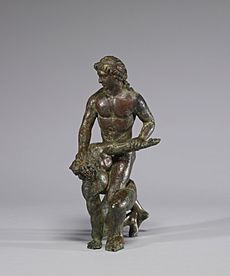
However, the Ptolemies generally supported Egyptian religion. It was always key to their power. Egyptian priests and religious leaders received royal support. They mostly kept their special status. Temples remained important for social, economic, and cultural life. The first three kings built many temples. They also finished projects from the previous dynasty. Many old or neglected buildings were fixed. The Ptolemies usually followed traditional building styles. In many ways, Egyptian religion thrived. Temples became centers of learning and literature in the Egyptian style. The worship of Isis and Horus became more popular. Offering animal mummies also became common.
Memphis was no longer the capital. But it became the second most important city after Alexandria. It had a lot of influence. Its High Priests of Ptah had great power among the priests. They even influenced the Ptolemaic kings. Saqqara, the city's burial ground, was a main center for worshipping the Apis bull. This bull became part of the national story. The Ptolemies also paid attention to Hermopolis. This was the center for worshipping Thoth. They built a Greek-style temple there. Thebes continued to be a major religious center. It was home to powerful priests. It also received royal development, like the Karnak complex. The city's temples and communities grew rich. New Ptolemaic style cemeteries were built.
A common stone tablet from the Ptolemaic Dynasty is the cippus. This was a religious object made to protect people. These magical tablets were made of different materials. They were used for health and safety. Horus on the Crocodiles cippi usually showed the child god Horus. This refers to the myth of Horus winning over dangerous animals with magic.
Ptolemaic Society
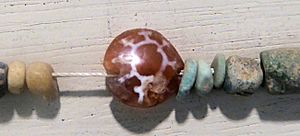
Ptolemaic Egypt had different social classes and languages. The Ptolemies kept many parts of the Egyptian social order. They used Egyptian religion, traditions, and political structures. This helped them gain more power and wealth.
As before, most people were peasant farmers. The state, temples, or noble families owned the land and its produce. Macedonians and other Greeks became the new upper classes. They replaced the old Egyptian nobles. A complex government system was set up. It managed Egypt's great wealth for the Ptolemies and landowners.
Greeks held almost all the political and economic power. Native Egyptians usually had only lower jobs. Over time, Egyptians who spoke Greek could advance more. Many people called "Greek" were actually of Egyptian descent. Eventually, a group of people who spoke both languages and had both cultures appeared. Priests and religious officials were mostly Egyptian. They continued to receive royal support and respect. The Ptolemies relied on Egyptian faith to make their rule seem right.
Egypt was a rich kingdom. The Ptolemies spent a lot on religious buildings and public works. But the native people got few benefits. Wealth and power stayed mostly with the Greeks. So, uprisings and social unrest were common. This was especially true by the early 3rd century BC. Egyptian nationalism was strongest during Ptolemy IV Philopator's rule. During this time, self-proclaimed "pharaohs" took control of some areas. This was stopped 19 years later by Ptolemy V Epiphanes. But the underlying problems never went away. Riots happened again later in the dynasty.
Ptolemaic Coins
Ptolemaic Egypt made many coins. They used gold, silver, and bronze. These included large coins in all three metals. Famous ones were gold pentadrachm and octadrachm. Silver coins included tetradrachm, decadrachm, and pentakaidecadrachm.
Ptolemaic Military
The Ptolemaic military was one of the best in the Hellenistic period. It had many resources. It could also change to fit new situations. At first, the military defended the kingdom. It fought against rival Greek states like the Seleucid Empire. By Ptolemy III's rule (246 to 222 BC), it became more about expanding the empire. It helped Ptolemaic control spread over Cyrenaica, Coele-Syria, and Cyprus. It also controlled cities in Anatolia, southern Thrace, the Aegean islands, and Crete. The military expanded these lands. It also kept protecting Egypt. Its main bases were in Alexandria, Pelusium, and Elephantine. The Ptolemies also used the military to keep control over Egypt. Soldiers served in the royal guard. They were used against uprisings and people trying to take the throne. These became more common over time. Soldiers, like the machimoi (low-ranking native soldiers), sometimes guarded officials. They even helped collect taxes.
The Ptolemaic Army
The Ptolemies always had a standing army. It was made of professional soldiers (including mercenaries) and new recruits. From the start, the Ptolemaic army was clever and flexible. To control Egypt, Ptolemy I used Greek troops, mercenaries, native Egyptians, and even war prisoners. The army was diverse. It kept records of where its troops came from. Soldiers were recruited from Macedonia, Libya, Greece, Asia Minor, and Thrace. Overseas lands often had local soldiers.
By the 2nd and 1st centuries BC, there was more warfare. Fewer Greeks moved to Egypt. This led to more reliance on native Egyptians. However, Greeks kept the higher ranks. They were royal guards, officers, and generals. Native troops were in the military from the beginning. But they were sometimes looked down upon. They were seen as disloyal and likely to join revolts. However, they were good fighters. Starting with Ptolemy V's changes in the early 3rd century BC, they appeared more often as officers and cavalry. Egyptian soldiers also had a higher social status than average Egyptians.
To get loyal soldiers, the Ptolemies used their wealth. They also used Egypt's reputation for riches. Mercenaries were paid a salary of cash and grain. A foot soldier in the 3rd century BC earned about one silver drachma daily. This attracted recruits from all over the eastern Mediterranean. They were sometimes called misthophoroi xenoi (foreigners paid with a salary). By the 2nd and 1st centuries BC, misthophoroi were mostly recruited from within Egypt. Soldiers were also given land grants called kleroi. Their size depended on rank and unit. They also got stathmoi, or homes. Sometimes these were in local people's houses. Men who settled in Egypt through these grants were called cleruchs. From about 230 BC, these land grants were given to machimoi. These were lower-ranking foot soldiers, usually Egyptian. They received smaller plots of land. Kleroi grants could be large. A cavalryman could get at least 70 arouras of land. This is about 178,920 square meters. An infantryman could expect 30 or 25 arouras. Machimoi got at least five arouras, enough for one family. The good pay for military service seemed to ensure loyalty. Few revolts are recorded. Even rebellious troops were calmed with land grants.
Like other Hellenistic states, the Ptolemaic army used Macedonian ways. But there were some changes over time. The army's core was cavalry and infantry. Cavalry played a bigger role. The Macedonian phalanx was the main infantry formation. The army had many different ethnic groups. This was an official rule. Soldiers were trained based on where they came from. Cretans were archers, Libyans were heavy infantry, and Thracians were cavalry. Units were grouped by ethnicity. However, different groups were trained to fight together. Most officers were Greek or Macedonian. This helped with teamwork. Military leaders and the king and queen were important for unity. At the Battle of Raphia, Ptolemy's presence helped Greek and Egyptian soldiers fight better.
The Ptolemaic Kingdom was a major naval power in the eastern Mediterranean. Some historians say Egypt was a "sea power" during this time. This is because it used new ways of sea power. This allowed its rulers to have great power and influence. With lands and allies across the eastern Mediterranean, the Ptolemies needed a large navy. This was to defend against enemies like the Seleucids and Macedonians. The Ptolemaic navy also protected the kingdom's trade by sea. It fought against pirates, even along the Nile.
Like the army, the navy's beginnings were in the wars after Alexander's death. Different generals fought for control of the sea. Ptolemy I started the navy. This was to defend Egypt and keep his control. He and his successors built up the navy to project power overseas. They did not try to build a land empire in Greece or Asia. The Ptolemaic navy became the main sea force in the Aegean and eastern Mediterranean. This was for several decades. Ptolemy II Philadelphus continued his father's policy. During his rule (283 to 246 BC), the Ptolemaic navy became the largest in the Hellenistic world. It had some of the biggest warships ever built in ancient times. The navy was strongest after Ptolemy II's victory in the First Syrian War (274–271 BC). It stopped Seleucid and Macedonian control of the eastern Mediterranean. During the Chremonidean War, the Ptolemaic navy blocked Macedonia. This kept its imperial plans to mainland Greece.
Starting with the Second Syrian War (260–253 BC), the navy lost many battles. It became less important. This happened as Egypt lost its overseas lands. The navy was mainly used for protection and fighting pirates. This lasted for 200 years. Then, Cleopatra VII partly brought it back. She wanted to restore Ptolemaic naval power. Egyptian naval forces fought in the battle of Actium. This was during the last war of the Roman Republic. But they lost again. This led to the end of Ptolemaic rule.
At its peak under Ptolemy II, the Ptolemaic navy may have had 336 warships. Ptolemy II reportedly had over 4,000 ships. This included transport ships and allied vessels. Keeping such a large fleet would have been very expensive. It shows the kingdom's great wealth. The main naval bases were at Alexandria and Nea Paphos in Cyprus. The navy operated throughout the eastern Mediterranean, Aegean Sea, and Levantine Sea. It also patrolled along the Nile and in the Red Sea towards the Indian Ocean. Naval forces were divided into four fleets: Alexandrian, Aegean, Red Sea, and Nile River.
Important Cities
While ruling Egypt, the Ptolemaic Dynasty built many Greek settlements. These were to make new conquered people more Greek. Or they were to strengthen the area. Egypt had only three main Greek cities: Alexandria, Naucratis, and Ptolemais.
Naucratis: A Greek City-State
Naucratis was one of the three Greek cities. Its trade importance lessened when Alexandria was founded. But it continued as a quiet Greek city-state. After Alexander died and before Ptolemy became king, it even made its own coins. Many Greek writers from the Ptolemaic and Roman periods were citizens of Naucratis. This shows that Naucratis kept its Greek culture. Ptolemy II cared for Naucratis. He built a large limestone structure, about 100 meters (328 ft) long and 18 meters (59 ft) wide. This filled a broken entrance to a great temple area. He strengthened a block of rooms in the temple area and rebuilt them. The great temple area was once thought to be a Greek building. But it was an Egyptian temple. So, Naucratis had an Egyptian part, even with its Greek character. The city was rich in Ptolemaic times. This is shown by the many imported jars found there. These jars had stamps from Rhodes and other places. Writings show it was the main port on the trip from Memphis to Alexandria. It was also a stop on the land route from Pelusium to the capital. It was part of the Saïte region in the government system.
Alexandria: The Capital City
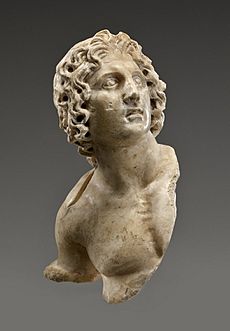
Alexandria is a major port in Egypt. It was founded in 331 BC by Alexander the Great. People in Alexandria believed Alexander wanted to build a large Greek city named after him. The city was located 30 kilometers (19 miles) west of the Nile's westernmost mouth. This meant it was safe from the silt that often blocked harbors along the river. Alexandria became the capital of Greek-influenced Egypt under King Ptolemy I. Under the rich Ptolemaic Dynasty, the city soon became more important than Athens. It was the cultural center of the Hellenic world.
Alexandria was built on a grid pattern. It stretched between the sea to the north and Lake Mareotis to the south. A man-made road, over three-quarters of a mile long, went north to the island of Pharos. This created two harbors, east and west. The main harbor was the Great Harbor in the east. It faced the city's main buildings. These included the royal palace and the famous Library and Museum. At the Great Harbor's entrance, on Pharos, stood the lighthouse. It was built around 280 BC. It is now gone. But it was considered one of the Seven Wonders of the World. This was because of its great height (perhaps 140 meters or 460 ft). It was a square tower with windows. It had a metal fire basket on top and a statue of Zeus the Savior.
The Library, the largest in the world at that time, held hundreds of thousands of books. It housed and employed scholars and poets. A similar scholarly place was the Museum (Mouseion, "hall of the Muses"). During Alexandria's short golden age of literature, around 280–240 BC, the Library supported three poets. These were Callimachus, Apollonius of Rhodes, and Theocritus. Their work is some of the best Greek literature from that time. Other thinkers linked to the Library were the mathematician Euclid (around 300 BC). Also, the inventor Archimedes (287 BC – around 212 BC). And the scholar Eratosthenes (around 225 BC).
Alexandria was a diverse and thriving city. It had Greeks, Egyptians, and other people from the East. It also had many Jews, who had their own part of the city. There were sometimes fights between Jews and Greeks. According to Strabo, Alexandria had local Egyptians, foreign soldiers, and Alexandrians. Polybius said the Alexandrians were Greek in origin and customs.
The city had a calm political history under the Ptolemies. It became part of Roman hands in 30 BC. It then became the second most important city of the Roman Empire.
Ptolemais: A Greek City in Upper Egypt
The second Greek city founded after Egypt was conquered was Ptolemais Hermiou. It was 400 miles (644 km) up the Nile. There was a native village there called Psoï. This village was in the region named after the ancient Egyptian city of Thinis. Alexandria honored Alexander. Ptolemais was built to honor Ptolemy I, the founder of the Ptolemaic time. It was surrounded by the dry hills of the Nile Valley and the Egyptian sky. Here, a Greek city grew. It had public buildings, temples, and a theater. These showed typical Greek architecture. The citizens were Greek by blood. The city had the systems of a Greek city. Alexandria might not have had a council and assembly. But Ptolemais definitely did. It was easier for the kings to let people govern themselves there. This was because it was far from the royal court. We still have stone writings of decisions made by the people of Ptolemais. These are in the usual style of Greek political tradition.
Population and Society
The Ptolemaic Kingdom was diverse. Starting with Ptolemy I Soter, Macedonians and other Greeks were given land. They were allowed to settle with their families. This encouraged tens of thousands of Greek soldiers to move there. They became a land-owning class of royal soldiers. Greeks soon became the ruling group. Native Egyptians, though always the majority, usually held lower jobs in the Ptolemaic government. Over time, the Greeks in Egypt became more similar. The cultural differences between Greeks from different regions faded.
Many Jews were brought from nearby Judea. They were known as good fighters. They also formed an important community. Other foreign groups settled from across the ancient world. They were usually cleruchs, who got land for military service.
Of the many foreign groups, the Greeks had the most privileges. They were spread out as landholders across the country. They formed social groups in towns and villages, alongside the native people. They also gathered in the three Greek cities. These were old Naucratis, founded before 600 BC. And the two new cities, Alexandria by the sea, and Ptolemais in Upper Egypt. Alexander and his successors founded many Greek cities.
Greek culture was tied to the city-state. Any king who wanted to be seen as a true supporter of Greek culture had to build cities. But the king of Egypt would find Greek cities difficult. They had a tradition of self-rule. Egypt was a country that easily allowed central control. So, the Ptolemies limited the number of Greek city-states in Egypt to Alexandria, Ptolemais, and Naucratis.
Outside Egypt, the Ptolemies controlled Greek cities in Cyrenaica, Cyprus, and on the coasts and islands of the Aegean. But these were smaller than the Greek cities in Egypt. There were country towns with names like Ptolemais, Arsinoe, and Berenice. Greek communities lived there with some social life. There were similar groups of Greeks in many old Egyptian towns. But they were not communities with the political forms of a city-state. Yet, even without a political assembly, they often had their own gymnasium. This was a key sign of Greek culture. It served as a kind of university for young men. Far up the Nile at Ombi, a gymnasium of local Greeks was found. It passed resolutions and wrote to the king. Also, in 123 BC, there was trouble in Upper Egypt. The towns of Crocodilopolis and Hermonthis had issues. Negotiators from Crocodilopolis were young men from the gymnasium. They shared a meal with negotiators from the other town, as was Greek tradition. All Greek dialects slowly became one common language. This was the Koine Greek dialect. Generally, the Greeks in Ptolemaic Egypt felt they had a higher civilization. But they were curious about Egyptian culture.
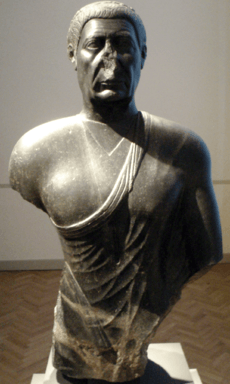
Jewish Communities
The Jews who lived in Egypt had moved from the Southern Levant. They learned Greek, which was the main language in Egypt. They mixed it with Hebrew. The Septuagint, a Greek translation of Jewish scriptures, was created. It was written by 70 Jewish translators. They were asked to translate Jewish sacred texts into Greek for Ptolemy II. Historian Flavius Josephus confirms this. He writes that Ptolemy wanted to collect every book. He asked Demetrius Phalereus to organize the translation of Jewish law books. Josephus says the Septuagint started in the 3rd century BC. This was when Demetrius and Ptolemy II lived. According to one Jewish legend, the 70 translators wrote their versions from memory. All the versions were exactly the same. However, Josephus says they worked together. They argued over the translation and finished in 72 days. Josephus describes the detailed preparations and royal treatment of the 70 elders. This is in his book Antiquities of the Jews, Book 12, chapter 2.
Arab Presence
In 1990, over 2,000 papyri were found. They were written by Zeno of Caunus during Ptolemy II Philadelphus's time. These papers mentioned Arabs at least 19 times. They were in the area between the Nile and the Red Sea. Some were police officers in charge of "ten person units." Others were shepherds. Arabs in Ptolemaic Egypt or Syria raided both sides in conflicts.
Agriculture and Farming
The early Ptolemies made more land available for farming. They did this through irrigation and reclaiming land. The Ptolemies drained the marshes of the Faiyum. This created a new area of farmland. They also brought in new crops like durum wheat. They increased the production of goods like wool. Wine production grew a lot during the Ptolemaic period. The new Greek rulers preferred wine over the traditional Egyptian beer. Vines from places like Crete were planted in Egypt. This was an effort to make Greek wines.
See also
 In Spanish: Período helenístico de Egipto para niños
In Spanish: Período helenístico de Egipto para niños


